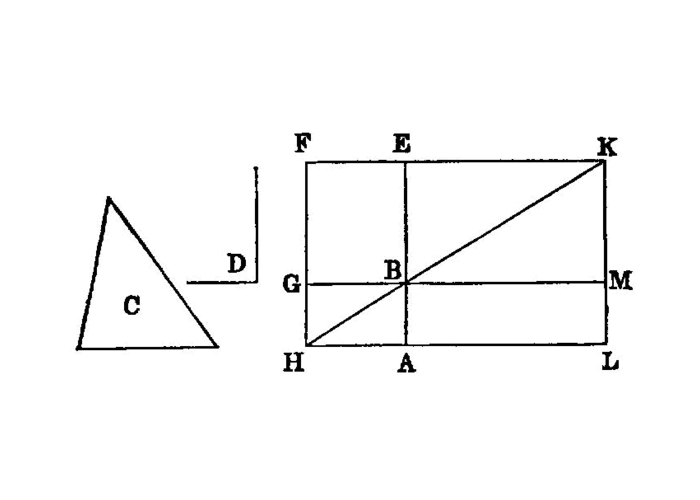Proposition I.44

To a given straight line to apply, in a given rectilineal angle, a parallelogram equal to a given triangle.
Let AB be the given straight line, C the given triangle and D the given rectilineal angle; thus it is required to apply to the given straight line AB, in an angle equal to the angle D, a parallelogram equal to the given triangle C.
Let the parallelogram BEFG be constructed equal to the triangle C, in the angle EBG which is equal to D I.42; let it be placed so that BE is in a straight line with AB; letFG be drawn through to H, and let AH be drawn through A parallel to either BG or EF. I.31
Let HB be joined.
Then, since the straight line HF falls upon the parallels AH, EF, 1
- the angles
AHF,HFEare equal to two right angles. I.29
Therefore the angles BHG, GFE are less than two right angles; and straight lines produced indefinitely from angles less than two right angles meet; I.post.5
- therefore
HB,FE, when produced, will meet.
Let them be produced and meet at K; through the point K let KL be drawn parallel to either EA or FH, I.31 and let HA, GB be produced to the points L, M.
Then HLKF is a parallelogram, HK is its diameter, and AG, ME are parallelograms. and LB, BF the so-called complements, about HK;
- therefore
LBis equal toBF. I.43
But BF is equal to the triangle C;
- therefore
LBis also equal toC. I.c.n.1
And, since the angle GBE is equal to the angle ABM, I.15
- while the angle
GBEis equal toD, the angleABMis also equal to the angleD.
Therefore the parallelogram LB equal to the given triangle C has been applied to the given straight line AB, in the angle ABM which is equal to D.
- Q. E. F.
References
Footnotes
-
since the straight line HF falls...."
The verb is in the aorist (ὲνέπεσεν ) here and in similar expressions in the following propositions. ↩
